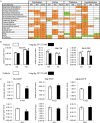Broad and Region-Specific Impacts of the Synthetic Cannabinoid CP 55,940 in Adolescent and Adult Female Mouse Brains
- PMID: 30542263
- PMCID: PMC6277767
- DOI: 10.3389/fnmol.2018.00436
Broad and Region-Specific Impacts of the Synthetic Cannabinoid CP 55,940 in Adolescent and Adult Female Mouse Brains
Abstract
Relative to Δ9-tetrahydrocannabinol (THC), the synthetic cannabinoid CP 55,940 (CP) is significantly more potent and efficacious at cannabinoid receptors, the primary targets for endogenous cannabinoids (eCBs). eCBs belong to a large, interconnected lipidome of bioactive signaling molecules with a myriad of effects in optimal and pathological function. Recreational use of highly potent and efficacious synthetic cannabinoids is common amongst adolescents, potentially impacting brain development. Knowledge of the molecular outcomes of synthetic cannabinoid use will be important to develop more targeted therapies for synthetic cannabinoid intoxication and to prevent long-term disruption to the CNS. Here, we test the hypothesis that CP has age and region-dependent effects on the brain lipidome. Adolescent [post-natal day (PND) 35 and PND 50] and young adult female mice were given either an acute dose of CP or vehicle and brains were collected 2 h later. Eight brain regions were dissected and levels of ∼80 lipids were screened from each region using HPLC/MS/MS. CP had widespread effects on the brain lipidome in all age groups. Interestingly, more changes were observed in the PND 35 mice and more were reductions in a lipid's concentration, including region-dependent lowering of eCB levels. CP levels were highest in the cortex at PND 35, the hippocampus at PND 50, and in the cerebellum in the adult. These data provide novel insights into how high-potency, synthetic cannabinoids drive different, age-dependent, cellular signaling effects in the brain.
Keywords: CNS; endogenous cannabinoid; lipidomics; lipoamine; prostaglandin; synthetic cannabinoid.
Figures





Similar articles
-
Δ9-Tetrahydrocannabinol changes the brain lipidome and transcriptome differentially in the adolescent and the adult.Biochim Biophys Acta Mol Cell Biol Lipids. 2018 May;1863(5):479-492. doi: 10.1016/j.bbalip.2018.02.001. Epub 2018 Feb 8. Biochim Biophys Acta Mol Cell Biol Lipids. 2018. PMID: 29408467 Free PMC article.
-
Chronic cannabinoid administration alters cannabinoid receptor binding in rat brain: a quantitative autoradiographic study.Brain Res. 1993 Jul 9;616(1-2):293-302. doi: 10.1016/0006-8993(93)90220-h. Brain Res. 1993. PMID: 8395305
-
Elevated Levels of Arachidonic Acid-Derived Lipids Including Prostaglandins and Endocannabinoids Are Present Throughout ABHD12 Knockout Brains: Novel Insights Into the Neurodegenerative Phenotype.Front Mol Neurosci. 2019 May 31;12:142. doi: 10.3389/fnmol.2019.00142. eCollection 2019. Front Mol Neurosci. 2019. PMID: 31213981 Free PMC article.
-
Behavioral effects of cannabinoid agents in animals.Crit Rev Neurobiol. 1999;13(3):243-81. doi: 10.1615/critrevneurobiol.v13.i3.20. Crit Rev Neurobiol. 1999. PMID: 10803637 Review.
-
Therapeutic potential of cannabinoids in CNS disease.CNS Drugs. 2003;17(3):179-202. doi: 10.2165/00023210-200317030-00004. CNS Drugs. 2003. PMID: 12617697 Review.
Cited by
-
Effects of combined use of alcohol and delta-9-tetrahydrocannibinol on working memory in Long Evans rats.Behav Brain Res. 2023 Jul 9;449:114475. doi: 10.1016/j.bbr.2023.114475. Epub 2023 May 3. Behav Brain Res. 2023. PMID: 37146720 Free PMC article.
-
Abnormalities of the endocannabinoid system produce piercing nuclear hernias in migrating cerebral neurons.iScience. 2025 Jul 23;28(8):113188. doi: 10.1016/j.isci.2025.113188. eCollection 2025 Aug 15. iScience. 2025. PMID: 40799395 Free PMC article.
-
Cannabis in Adolescence: Lasting Cognitive Alterations and Underlying Mechanisms.Cannabis Cannabinoid Res. 2023 Feb;8(1):12-23. doi: 10.1089/can.2022.0183. Epub 2022 Oct 26. Cannabis Cannabinoid Res. 2023. PMID: 36301550 Free PMC article. Review.
-
Effects of combined use of alcohol and delta-9-tetrahydrocannibinol on working memory in Long Evans rats.bioRxiv [Preprint]. 2023 Mar 31:2023.02.02.526698. doi: 10.1101/2023.02.02.526698. bioRxiv. 2023. Update in: Behav Brain Res. 2023 Jul 9;449:114475. doi: 10.1016/j.bbr.2023.114475. PMID: 36778500 Free PMC article. Updated. Preprint.
-
Reduced fetal cerebral blood flow predicts perinatal mortality in a mouse model of prenatal alcohol and cannabinoid exposure.BMC Pregnancy Childbirth. 2024 Apr 11;24(1):263. doi: 10.1186/s12884-024-06436-9. BMC Pregnancy Childbirth. 2024. PMID: 38605299 Free PMC article.
References
-
- Abboussi O., Tazi A., Paizanis E., El Ganouni S. (2014). Chronic exposure to WIN55,212-2 affects more potently spatial learning and memory in adolescents than in adult rats via a negative action on dorsal hippocampal neurogenesis. Pharmacol. Biochem. Behav. 120 95–102. 10.1016/j.pbb.2014.02.014 - DOI - PubMed
-
- Alexandrescu L. (2018). ‘Ethnobotanicals’ and ‘Spice zombies’: new psychoactive substances in the mainstream media. Drugs Educ. Prev. Policy 25 356–364. 10.1080/09687637.2017.1397101 - DOI
-
- Baggelaar M. P., Janssen F. J., van Esbroeck A., den Dulk H., Allarà M., Hoogendoorn S., et al. (2013). Development of an activity-based probe and in silico design reveal highly selective inhibitors for diacylglycerol lipase-α in brain. Angew. Chem. Int. Ed. 52 12081–12085. 10.1002/anie.201306295 - DOI - PubMed
-
- BBC News (2018). ‘Devastating’ Impact of ‘Spice’ Shown in Image in Bridgend. London: BBC News.
Grants and funding
LinkOut - more resources
Full Text Sources
Miscellaneous

